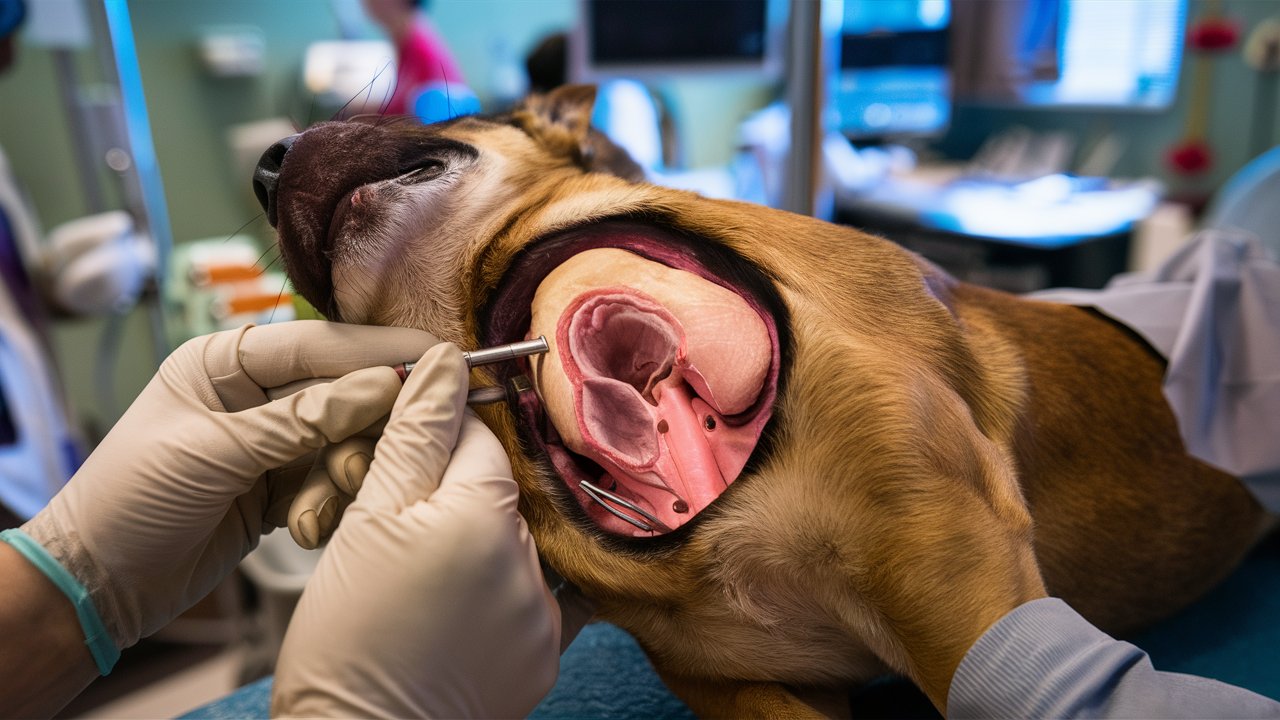Mitral Valve Disease in Dogs:100% Comprehensive Guide
Table of Contents
ToggleIntroduction About Mitral Valve Disease in Dogs

Mitral Valve Disease in dogs (MVD) is a progressive and unfortunately common heart condition in dogs, particularly affecting older small breeds such as Cavalier King Charles Spaniels, Dachshunds, and Chihuahuas. This disease primarily involves the deterioration of the mitral valve, a crucial component of the heart that regulates blood flow between the left atrium and left ventricle. As the valve degenerates, it fails to close properly, leading to backflow of blood into the atrium and causing the heart to work harder to compensate.
Mitral Valve Disease in Dogs typically manifests as a murmur during routine veterinary examinations, indicating abnormal blood flow through the heart. Over time, the condition progresses, often leading to congestive heart failure—a stage where the heart can no longer pump blood effectively, leading to fluid buildup in the lungs and other organs.
Prevalence and Risk Factors
The prevalence of Mitral Valve Disease in Dogs is notably higher in certain small breeds, with studies indicating that up to 75% of Cavalier King Charles Spaniels may develop the condition by the age of 10. Other predisposed breeds include the Miniature Poodle, Yorkshire Terrier, and Maltese. While primarily seen in older dogs, Mitral Valve Disease in Dogs can occasionally affect younger animals due to genetic predispositions or congenital defects.
Importance of Early Detection
Early detection of Mitral Valve Disease in Dogs is crucial for implementing effective management strategies to improve quality of life and potentially prolong lifespan. Regular veterinary check-ups, especially in aging dogs or predisposed breeds, can help identify murmurs or other early signs of heart disease. Diagnostic tools such as echocardiography play a pivotal role in assessing the severity of valve degeneration and monitoring heart function over time.
Impact on Quality of Life
The progressive nature of Mitral Valve Disease in Dogs means that affected dogs may experience varying degrees of symptoms, from mild coughing and exercise intolerance to more severe breathing difficulties and fluid accumulation. Understanding these symptoms allows pet owners to intervene early with appropriate medical treatment and lifestyle adjustments to optimize their dog’s comfort and well-being.
Personal Connection and Advocacy
Many pet owners find themselves deeply connected to their dogs’ health journeys, especially when managing chronic conditions like Mitral Valve Disease in Dogs. Personal stories and anecdotes not only illustrate the challenges faced but also highlight the resilience and companionship shared between pets and their owners. These narratives underscore the importance of awareness, advocacy, and ongoing support within the veterinary community to improve outcomes for dogs affected by heart disease.
What is Mitral Valve Disease?
Mitral Valve Disease in Dogs (MVD) is the most common acquired heart disease in dogs, particularly affecting older small breeds such as Cavalier King Charles Spaniels, Dachshunds, and Chihuahuas. It primarily involves degeneration of the mitral valve, located between the left atrium and left ventricle of the heart. This valve normally ensures that blood flows in one direction, preventing backflow into the atrium during ventricular contraction.
Pathophysiology of Mitral Valve Disease in Dogs
The disease typically begins with structural changes in the mitral valve leaflets, which become thickened and less pliable over time. As the condition progresses, the valve may develop nodules or ruptures, leading to incomplete closure and allowing blood to leak backward (regurgitation) into the left atrium. This regurgitation causes the heart to work harder to compensate for the decreased efficiency, leading to enlargement and weakening of the heart muscle over time.
Risk Factors of Mitral Valve Disease in Dogs
Certain breeds, such as Cavalier King Charles Spaniels, are genetically predisposed to Mitral Valve Disease in Dogs, suggesting a hereditary component. Age is another significant risk factor, with most cases diagnosed in dogs over the age of five. However, the disease can also affect younger dogs, albeit less commonly.
Progression of the Disease
Mitral Valve Disease in Dogs progresses gradually, often starting with mild symptoms that may go unnoticed until the disease reaches more advanced stages. The rate of progression varies among dogs and can be influenced by factors such as the size of the dog, the severity of valve degeneration, and overall heart health.
Symptoms and Clinical Signs about Mitral Valve Disease in Dogs
Early stages of Mitral Valve Disease in Dogs may be asymptomatic or present with subtle signs that can easily be attributed to aging or other conditions. As the disease advances, common symptoms include:
- Coughing: Initially mild and sporadic, progressing to more frequent bouts, especially at night or after activity.
- Labored Breathing (Dyspnea): Difficulty breathing, rapid or shallow breathing.
- Exercise Intolerance: Reluctance to engage in physical activity or tiring quickly.
- Weakness and Fatigue: Reduced stamina and energy levels.
- Fluid Build-up (Edema): Swelling of the abdomen or limbs due to fluid retention.
Diagnosis
Diagnosing Mitral Valve Disease in Dogs typically involves a combination of thorough physical examination, auscultation (listening to heart sounds), and diagnostic imaging techniques such as echocardiography. Echocardiography is particularly useful for assessing the severity of mitral valve regurgitation, evaluating the size and function of the heart chambers, and detecting any signs of heart failure.
Prognosis and Treatment Options
The prognosis for dogs with Mitral Valve Disease in Dogs varies depending on the stage of the disease at diagnosis and the effectiveness of treatment. While Mitral Valve Disease in Dogs is incurable, the goals of treatment are to manage symptoms, slow disease progression, and improve quality of life. Treatment options include:
- Medication: Including diuretics to reduce fluid buildup, ACE inhibitors to dilate blood vessels and reduce blood pressure, and pimobendan to enhance heart function.
- Dietary Management: Low-sodium diets help reduce fluid retention and ease the workload on the heart.
- Regular Monitoring: Routine veterinary check-ups and diagnostic tests are essential for monitoring disease progression and adjusting treatment as needed.
- Surgical Options: In some cases, advanced surgical procedures such as valve repair or replacement may be considered, particularly for dogs with severe valve damage or heart failure.
Living with Mitral Valve Disease in Dogs
Caring for Mitral Valve Disease in Dogs involves understanding their limitations and adapting their lifestyle to accommodate their condition. This includes providing a low-stress environment, moderate exercise tailored to their capabilities, and ensuring adherence to prescribed medications and dietary guidelines.
Symptoms and Diagnosis about Mitral Valve Disease in Dogs

Symptoms of Mitral Valve Disease in Dogs
Mitral Valve Disease in dogs manifests differently depending on the stage and severity of the condition. Early signs may be subtle and easily missed, while advanced stages present more pronounced symptoms:
- Coughing: Persistent coughing, especially at night or after exertion, is one of the earliest indicators of MVD. The cough is typically dry and can worsen as the disease progresses.
- Labored Breathing: Dogs with MVD may experience difficulty breathing, characterized by rapid or shallow breaths. This symptom often correlates with fluid accumulation in the lungs (pulmonary edema).
- Exercise Intolerance: As the heart’s ability to pump blood efficiently declines, affected dogs may show reluctance to engage in physical activities they once enjoyed. They may tire more quickly or seem less enthusiastic about exercise.
- Weakness and Fatigue: Generalized weakness or lethargy can accompany MVD, reflecting the body’s struggle to maintain adequate oxygen supply to tissues.
- Fluid Build-up: In advanced stages, fluid retention can lead to visible symptoms such as a swollen abdomen (ascites) or limbs (edema). These occur due to fluid accumulation in the abdomen or extremities.
- Heart Murmurs: A characteristic heart murmur, detected during auscultation with a stethoscope, is often one of the first clinical signs noticed by veterinarians during routine examinations. Murmurs indicate turbulent blood flow through the damaged mitral valve.
Diagnosis of Mitral Valve Disease
Early detection and accurate diagnosis are essential for managing MVD effectively. Veterinary diagnosis typically involves the following steps:
- Physical Examination: A thorough physical assessment includes evaluating the dog’s heart rate, rhythm, and listening for abnormal heart sounds (murmurs).
- Auscultation: Using a stethoscope, veterinarians listen to the heart sounds to detect murmurs and assess their intensity and location. This helps determine the severity of valve dysfunction.
- Diagnostic Imaging: Echocardiography (ultrasound of the heart) is a critical tool for diagnosing MVD. It allows veterinarians to visualize the heart’s structure and function, including the mitral valve and any abnormalities such as valve thickening, regurgitation (leakage), or chamber enlargement.
- X-rays: Chest radiographs (x-rays) help assess the size and shape of the heart and lungs. They can reveal signs of fluid accumulation in the lungs (pulmonary edema) or abdomen (ascites).
- Electrocardiography (ECG): In some cases, an ECG may be performed to assess the electrical activity of the heart and detect any arrhythmias (abnormal heart rhythms).
- Blood Tests: While not diagnostic for MVD itself, blood tests may be conducted to assess overall health and screen for concurrent conditions that could impact treatment decisions.
Early Detection and Monitoring
Early diagnosis of MVD allows for timely intervention and management strategies that can slow disease progression and improve quality of life. Regular veterinary check-ups, especially for susceptible breeds or older dogs, facilitate early detection through auscultation and diagnostic imaging.
Treatment Options

Mitral Valve Disease (MVD) is a prevalent heart condition in dogs, particularly affecting older small breeds such as Cavalier King Charles Spaniels, Dachshunds, and Chihuahuas. This progressive disease can significantly impact a dog’s quality of life, making awareness and early detection crucial for effective management.
What is Mitral Valve Disease?
Mitral Valve Disease occurs when the mitral valve, a crucial component of the heart responsible for regulating blood flow between the left atrium and left ventricle, deteriorates over time. This degeneration causes the valve to leak, leading to backflow of blood and ultimately compromising the heart’s ability to pump effectively.
Symptoms and Diagnosis
Early stages of MVD may not present noticeable symptoms, but as the disease progresses, common signs include:
- Coughing: Especially at night or after exercise.
- Labored Breathing: Difficulty breathing or rapid breathing.
- Fatigue: Reluctance to exercise or play.
- Fluid Build-up: Swollen abdomen or limbs due to fluid retention.
Diagnosis typically involves a combination of physical examination, auscultation (listening to heart sounds), and diagnostic imaging such as echocardiography to assess the extent of valve damage and heart function.
Treatment Options
While MVD is incurable, several treatment options can manage symptoms and slow disease progression:
Medication:
- Diuretics: These medications help manage fluid retention, reducing the workload on the heart and alleviating symptoms like coughing and edema.
- ACE Inhibitors: Angiotensin-converting enzyme (ACE) inhibitors dilate blood vessels, improving blood flow and reducing strain on the heart.
- Pimobendan: This medication enhances the heart’s ability to pump blood efficiently, improving cardiac function and prolonging survival in dogs with MVD.
Dietary Management:
- Low-Sodium Diets: Restricting sodium intake helps minimize fluid retention and reduces the risk of congestive heart failure.
- Balanced Nutrition: Providing a well-balanced diet with essential nutrients supports overall health and aids in managing weight, which is crucial for cardiovascular health.
Supplements:
- Omega-3 Fatty Acids: These supplements have anti-inflammatory properties and may support heart health.
- Coenzyme Q10: Helps improve cellular energy production in the heart muscle, potentially benefiting dogs with heart disease.
Monitoring and Regular Vet Visits:
- Regular check-ups are essential to monitor the progression of MVD and adjust treatment as needed.
- Diagnostic tests such as echocardiograms and blood tests help assess heart function and detect any changes early.
Surgical Options:
- In severe cases or when medications no longer control symptoms, surgical interventions may be considered.
- Valve Repair or Replacement: Surgical procedures to repair or replace the damaged mitral valve can improve heart function and quality of life, although these are complex procedures requiring specialized veterinary care.
Living with a Dog with MVD
Caring for a dog with MVD involves understanding their limitations and adapting their lifestyle accordingly:
- Exercise: Moderate, low-impact activities are beneficial, but avoid excessive exertion.
- Stress Management: Minimize stress and anxiety, as these can exacerbate symptoms.
- Quality of Life: Provide a comfortable environment with regular veterinary care and attention to dietary and medication needs.
Personal Stories and Anecdotes
Many pet owners share touching stories of their journey with a dog diagnosed with MVD. These anecdotes highlight the bond between owners and their pets, the challenges faced, and the resilience shown by their furry companions in coping with the disease.
Living with a Dog with MVD
Living with a dog diagnosed with Mitral Valve Disease (MVD) requires careful attention to their health and well-being. While there is no cure for MVD, proactive management and a supportive environment can greatly improve a dog’s quality of life.
Understanding Limitations and Adaptations
Dogs with MVD may experience varying degrees of symptom severity depending on the progression of the disease. It’s essential for owners to recognize their dog’s limitations and adapt their lifestyle accordingly:
- Exercise: Regular, moderate exercise is important to maintain muscle tone and overall health. However, intense physical activity should be avoided to prevent overexertion, which can strain the heart.
- Rest and Stress Management: Providing a calm and stress-free environment is crucial. Stress can exacerbate symptoms of MVD, so minimizing triggers such as loud noises or chaotic environments can help keep your dog comfortable.
Dietary Considerations
Diet plays a significant role in managing MVD in dogs:
- Low-Sodium Diet: Sodium restriction helps reduce fluid retention and decreases the workload on the heart. Many commercially available dog foods offer formulations specifically designed for dogs with heart disease.
- Balanced Nutrition: Ensuring your dog receives adequate nutrition is essential. Consult with your veterinarian to determine the best diet plan tailored to your dog’s specific needs and health status.
Medication and Treatment Adherence
Dogs with MVD often require lifelong medication to manage symptoms and slow disease progression:
- Medication Schedule: Follow your veterinarian’s prescribed medication schedule diligently. This may include diuretics to manage fluid buildup, ACE inhibitors to dilate blood vessels, and other medications to support heart function.
- Regular Veterinary Check-ups: Routine visits to the veterinarian are crucial to monitor your dog’s condition, adjust medications as necessary, and assess overall health.
Emotional Support and Quality of Life
Caring for a dog with MVD can be emotionally challenging. Providing consistent love, attention, and companionship is essential for their well-being:
- Bonding Time: Spend quality time with your dog, engaging in activities they enjoy without overexertion.
- Monitoring Changes: Be vigilant for any changes in behavior or physical symptoms and promptly consult your veterinarian if you notice anything unusual.
Supportive Care
As MVD progresses, your dog may require additional supportive care:
- Comfortable Environment: Ensure your dog has a comfortable living space with soft bedding and a cozy environment to rest.
- Assistive Devices: In some cases, your veterinarian may recommend assistive devices such as ramps or orthopedic beds to ease mobility and joint strain.
Personal Anecdotes and Stories
Sharing personal anecdotes can provide insight into the daily challenges and triumphs of living with a dog diagnosed with MVD. Many pet owners find comfort and support in connecting with others who understand the unique journey of caring for a dog with a chronic heart condition.
Personal Stories and Anecdotes
Personal stories and anecdotes from dog owners who have navigated life with a pet diagnosed with Mitral Valve Disease (MVD) provide valuable insights into the emotional journey, challenges faced, and moments of joy experienced along the way.
Emotional Impact and Bonding
Many pet owners describe the profound bond that develops when caring for Mitral Valve Disease in Dogs. This bond often deepens as owners become more attuned to their dog’s needs and strive to provide the best possible care:
- Shared Moments: Whether it’s quiet moments of companionship, playful interactions, or overcoming challenges together, these experiences strengthen the emotional connection between owners and their pets.
- Resilience and Strength: Mitral Valve Disease in Dogs often display remarkable resilience in coping with their condition. Their ability to adapt to lifestyle changes and continue enjoying life despite health challenges is inspiring to witness.
Challenges and Triumphs
Living with a dog with Mitral Valve Disease in Dogs presents both practical and emotional challenges:
- Managing Symptoms: The daily management of medications, dietary restrictions, and monitoring for changes in health can be demanding. However, each small improvement or stable period can feel like a triumph.
- Facing Uncertainty: The progressive nature of Mitral Valve Disease in Dogs can bring uncertainty about the future. Pet owners may navigate feelings of anxiety and sadness while striving to maintain a positive outlook and focus on their dog’s quality of life.
Support and Community
Engaging with support groups and online communities can provide invaluable support for pet owners navigating Mitral Valve Disease in Dogs:
- Shared Experiences: Connecting with others who understand the complexities of caring for a dog with heart disease can offer empathy, advice, and encouragement.
- Learning and Advocacy: Sharing personal stories not only provides emotional support but also raises awareness about Mitral Valve Disease in Dogs and encourages proactive veterinary care among pet owners.
Celebrating Life and Cherished Moments
Despite the challenges, many pet owners find joy in celebrating the unique personality and resilience of their dogs:
- Memorable Moments: From special outings to quiet evenings snuggled together, every moment shared with a dog with Mitral Valve Disease in Dogs becomes precious and cherished.
- Gratitude and Perspective: Owners often express gratitude for the love and companionship their dogs bring into their lives, emphasizing the importance of living in the moment and appreciating each day together.
Conclusion
Mitral Valve Disease in dogs is a complex condition that requires vigilance and proactive management. By understanding the symptoms, seeking early diagnosis, and implementing appropriate treatments, pet owners can significantly enhance the quality and longevity of their dog’s life. Personal anecdotes underscore the emotional impact of MVD, emphasizing the importance of awareness and compassionate care in supporting dogs affected by this challenging disease.
References
- Veterinary Cardiology Specialists
- American College of Veterinary Internal Medicine
- Pet MD and other reputable veterinary resources






